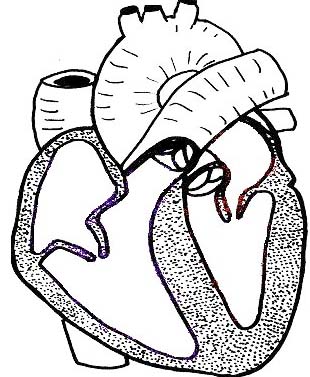REVIEW GUIDE - CARDIOVASCULAR SYSTEM

1. How do you calculate cardiac output (formula)? ___________________
2. Arteries carry blood [ away from / toward ] the heart.
Veins carry blood [ away from / toward ] the heart.
[ Arteries / Veins ] carry oxygenated blood.
Name the one vessel that is the exception: ___________________
3. What do you call the loose, outer layer of the sac around the heart?
_______________________
What is the inner layer? ______________ Outer? _________________
4. When vessels expand, it is called _____________________
When they contract? ____________________
5. Describe the epicardium, myocardium, and endocardium
6. Describe the size and location of the heart.
What is the apex of the heart and where is it located? ________________________
What divides the left and right side of the heart? __________________
Which side is more muscular? __________________ What bone lies directly in front of the heart? ____________
7. During systole, the aortic valve is __________________. During diastole, the aortic valve is __________________.
8. Veins and arteries meet at ________________________, where nutrients are exchanged with body tissues.
Arteries branch into smaller vessels called ______________________ .
Veins also have smaller branches called _______________________________
9. What aids in bringing blood back to the heart? _____________________________________________________
10. Trace the path of a nerve (cardiac) impulse through the cardiac conduction system.
What is the pacemaker? ____________________________
What fibers cause a contraction in the ventricle? ________________________
Where is the AV node located? ____________________________________
11. What do the terms tachycardia and bradycardia mean? What is arrhythmia? What is defibrillation?
12. How are the valves attached to the wall of the heart (2 structures)? ______________________________________
13. Generally speaking, when the ventricle contracts, the atrium ________________
Any contraction (atrial or ventricular) is called _________________ Relaxing is called ____________________.
14. What causes a P-Wave, the QRS complex and a T wave?
What is an ECG? * Be able to analyze one on the test.
15. What are systolic pressure and diastolic pressure? What is the “normal” blood pressure for a human?
16. What two pieces of equipment are needed to take a person’s blood pressure?
Describe the procedure:
17. Blood that moves from the heart to the lungs and back to the heart again is in the _____________________ circuit.
Blood moving throughout the body is in the ___________________ circuit.
18. Identify the three major vessels that branch off of the aortic arch. You may want to draw a diagram.
19. Label the heart and trace the flow of blood through the major vessels and all of the valves. (See image above)
20. Know the major disorders of the heart that we discussed in class and describe the treatment for each.
